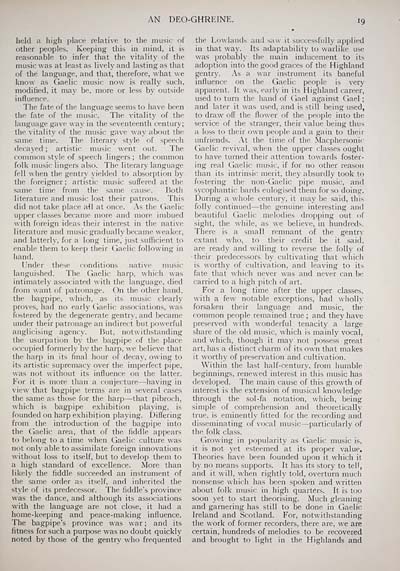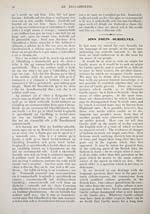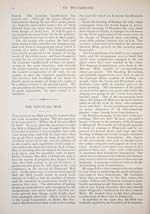Blair Collection > Deo-gréine
(35)
Download files
Complete book:
Individual page:
Thumbnail gallery: Grid view | List view

AN DEO-GHRFINF.
19
held a high place relative to the music of
other peoples. Keeping this in mind, it is
reasonable to infer that the vitality of the
music was at least as lively and lasting as that
of the language, and that, therefore, what we
know as Gaelic music now is really such,
modified, it may be, more or less by outside
influence.
The fate of the language seems to have been
the fate of the music. The vitality of the
language gave way in the seventeenth century;
the vitality of the music gave way about the
same time. The literary style of speech
decayed ; artistic music went out. The
common style of speech lingers ; the common
folk music lingers also. The literary language
fell when the gentry yielded to absorption by
the foreigner; artistic music suffered at the
same time from the same cause. Both
literature and music lost their patrons. This
did not take place all at once. As the Gaelic
upper classes became more and more imbued
with foreign ideas their interest in the native
literature and music gradually became weaker,
and latterly, for a long time, just sufficient to
enable them to keep their Gaelic following in
hand.
Under these conditions native music
languished. The Gaelic harp, which was
intimately associated with the language, died
from want of patronage. On the other hand,
the bagpipe, which, as its music clearly
proves, had no early Gaelic associations, was
Fostered by the degenerate gentry, and became
under their patronage an indirect but powerful
anglicising agency. But, notwithstanding
the usurpation by the bagpipe of the place
occupied formerly by the harp, we believe that
the harp in its final hour of decay, owing to
its artistic supremacy over the imperfect pipe,
was not without its influence on the latter.
For it is more than a conjecture — having in
view that bagpipe terms are in several cases
the same as those for the harp — that pibroch,
which is bagpipe exhibition playing, is
founded on harp exhibition playing. Differing
from the introduction of the bagpipe into
the Gaelic area, that of the fiddle appears
to belong to a time when Gaelic culture was
not only able to assimilate foreign innovations
without loss to itself, but to develop them to
a high standard of excellence. More than
likely the fiddle succeeded an instrument of
the same order as itself, and inherited the
style of its predecessor. The fiddle's province
was the dance, and although its associations
with the language are not close, it had a
home-keeping and peace-making influence.
The bagpipe's province was war ; and its
fitness for such a purpose was no doubt quickly
noted by those of the gentrv who frequented
the Lowlands and saw it successfully applied
in that way. Its adaptability to warlike use
was probably the main inducement to its
adoption into the good graces of the Highland
gentry. As a war instrument its baneful
influence on the Gaelic people is very
apparent. It was, early in its Highland career,
used to turn the hand of Gael against Gael ;
and later it was used, and is still being used,
to draw off the flower of the people into the
service of the stranger, their value being thus
a loss to their own people and a gain to their
unfriends. At the time of the Macphersonic
Gaelic revival, when the upper classes ought
to have turned their attention towards foster-
ing real Gaelic music-, if for no other reason
than its intrinsic merit, they absurdly took to
fostering the non-Gaelic pipe music, and
sycophantic bards eulogised them for so doing.
During a whole century, it may be said, this
folly continued — the genuine interesting and
beautiful Gaelic- melodies dropping out of
sight, the while, as we believe, in hundreds.
There is a small remnant of the gentry
extant who, to their credit be it said,
are ready and willing to reverse the folly of
their predecessors by cultivating that which
is worthy of cultivation, and leaving to its
fate that which never was and never can be
carried to a high pitch of art.
For a long time after the upper classes,
with a few notable exceptions, had wholly
forsaken their language and music, the
common people remained true ; and they have
preserved with wonderful tenacity a large
share of the old music, which is mainly vocal,
and which, though it may not possess great
art, has a distinct charm of its own that makes
it worthy of preservation and cultivation.
Within the last half -century, from humble
beginnings, renewed interest in this music has
developed. The main cause of this growth of
interest is the extension of musical knowledge
through the sol-fa notation, which, being
simple of comprehension and theoretically
true, is eminently fitted for the recording and
disseminating of vocal music — particularly of
the folk class.
Growing in popularity as Gaelic music is,
it is not yet esteemed at its proper value.
Theories have been founded upon it which it
by no means supports. It has its story to tell,
and it will, when rightly told, overturn much
nonsense which has been spoken and written
about folk music in high quarters. It is too
soon yet to start theorising. Much gleaning
and garnering has still to be done in Gaelic
Ireland and Scotland. For, notwithstanding
the work of former recorders, there are, we are
certain, hundreds of melodies to be recovered
and brought to light in the Highlands and
19
held a high place relative to the music of
other peoples. Keeping this in mind, it is
reasonable to infer that the vitality of the
music was at least as lively and lasting as that
of the language, and that, therefore, what we
know as Gaelic music now is really such,
modified, it may be, more or less by outside
influence.
The fate of the language seems to have been
the fate of the music. The vitality of the
language gave way in the seventeenth century;
the vitality of the music gave way about the
same time. The literary style of speech
decayed ; artistic music went out. The
common style of speech lingers ; the common
folk music lingers also. The literary language
fell when the gentry yielded to absorption by
the foreigner; artistic music suffered at the
same time from the same cause. Both
literature and music lost their patrons. This
did not take place all at once. As the Gaelic
upper classes became more and more imbued
with foreign ideas their interest in the native
literature and music gradually became weaker,
and latterly, for a long time, just sufficient to
enable them to keep their Gaelic following in
hand.
Under these conditions native music
languished. The Gaelic harp, which was
intimately associated with the language, died
from want of patronage. On the other hand,
the bagpipe, which, as its music clearly
proves, had no early Gaelic associations, was
Fostered by the degenerate gentry, and became
under their patronage an indirect but powerful
anglicising agency. But, notwithstanding
the usurpation by the bagpipe of the place
occupied formerly by the harp, we believe that
the harp in its final hour of decay, owing to
its artistic supremacy over the imperfect pipe,
was not without its influence on the latter.
For it is more than a conjecture — having in
view that bagpipe terms are in several cases
the same as those for the harp — that pibroch,
which is bagpipe exhibition playing, is
founded on harp exhibition playing. Differing
from the introduction of the bagpipe into
the Gaelic area, that of the fiddle appears
to belong to a time when Gaelic culture was
not only able to assimilate foreign innovations
without loss to itself, but to develop them to
a high standard of excellence. More than
likely the fiddle succeeded an instrument of
the same order as itself, and inherited the
style of its predecessor. The fiddle's province
was the dance, and although its associations
with the language are not close, it had a
home-keeping and peace-making influence.
The bagpipe's province was war ; and its
fitness for such a purpose was no doubt quickly
noted by those of the gentrv who frequented
the Lowlands and saw it successfully applied
in that way. Its adaptability to warlike use
was probably the main inducement to its
adoption into the good graces of the Highland
gentry. As a war instrument its baneful
influence on the Gaelic people is very
apparent. It was, early in its Highland career,
used to turn the hand of Gael against Gael ;
and later it was used, and is still being used,
to draw off the flower of the people into the
service of the stranger, their value being thus
a loss to their own people and a gain to their
unfriends. At the time of the Macphersonic
Gaelic revival, when the upper classes ought
to have turned their attention towards foster-
ing real Gaelic music-, if for no other reason
than its intrinsic merit, they absurdly took to
fostering the non-Gaelic pipe music, and
sycophantic bards eulogised them for so doing.
During a whole century, it may be said, this
folly continued — the genuine interesting and
beautiful Gaelic- melodies dropping out of
sight, the while, as we believe, in hundreds.
There is a small remnant of the gentry
extant who, to their credit be it said,
are ready and willing to reverse the folly of
their predecessors by cultivating that which
is worthy of cultivation, and leaving to its
fate that which never was and never can be
carried to a high pitch of art.
For a long time after the upper classes,
with a few notable exceptions, had wholly
forsaken their language and music, the
common people remained true ; and they have
preserved with wonderful tenacity a large
share of the old music, which is mainly vocal,
and which, though it may not possess great
art, has a distinct charm of its own that makes
it worthy of preservation and cultivation.
Within the last half -century, from humble
beginnings, renewed interest in this music has
developed. The main cause of this growth of
interest is the extension of musical knowledge
through the sol-fa notation, which, being
simple of comprehension and theoretically
true, is eminently fitted for the recording and
disseminating of vocal music — particularly of
the folk class.
Growing in popularity as Gaelic music is,
it is not yet esteemed at its proper value.
Theories have been founded upon it which it
by no means supports. It has its story to tell,
and it will, when rightly told, overturn much
nonsense which has been spoken and written
about folk music in high quarters. It is too
soon yet to start theorising. Much gleaning
and garnering has still to be done in Gaelic
Ireland and Scotland. For, notwithstanding
the work of former recorders, there are, we are
certain, hundreds of melodies to be recovered
and brought to light in the Highlands and
Set display mode to: Large image | Transcription
Images and transcriptions on this page, including medium image downloads, may be used under the Creative Commons Attribution 4.0 International Licence unless otherwise stated. ![]()
| Early Gaelic Book Collections > Blair Collection > Deo-gréine > (35) |
|---|
| Permanent URL | https://digital.nls.uk/76698078 |
|---|
| Description | A selection of books from a collection of more than 500 titles, mostly on religious and literary topics. Also includes some material dealing with other Celtic languages and societies. Collection created towards the end of the 19th century by Lady Evelyn Stewart Murray. |
|---|
| Description | Selected items from five 'Special and Named Printed Collections'. Includes books in Gaelic and other Celtic languages, works about the Gaels, their languages, literature, culture and history. |
|---|

